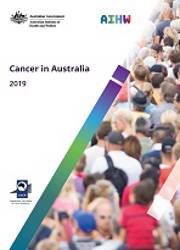Summary
Cancer is a major cause of illness in Australia—there are over 1 million people alive in Australia who are either living with or have lived with cancer. Around 30 years ago, about 5 in 10 people survived for at least 5 years after their cancer diagnosis; more recent figures are closer to 7 in 10 people surviving at least 5 years. Understanding and avoiding the risk factors associated with cancer can help to reduce the chance of getting cancer, while cancer screening programs increase the likelihood of detecting cancer early, enabling better outcomes from treatments. Improvements in treatments and care are also important contributors to improvements in survival.
Even though cancer survival rates have increased and cancer mortality rates continue to drop, cancer accounts for around 3 of every 10 deaths in Australia. Aboriginal and Torres Strait Islander people and people in lower socioeconomic groups both have lower cancer survival rates than other Australians. And while cancer survival rates have improved overall, people diagnosed with cancers such as pancreatic cancer, lung cancer and mesothelioma have a less than 1 in 5 chance, on average, of surviving at least 5 years after being diagnosed.
Cancer incidence rate on a downward trend since 2008
In 2008, cancer incidence (new diagnoses) rates peaked at an age-standardised rate of 508 cases per 100,000 persons. In 2019, it is estimated that almost 145,000 new cases of cancer (excluding basal and squamous cell carcinoma of the skin) will be diagnosed in Australia. The 2019 estimate equates to an age-standardised rate of 483 cases per 100,000 persons in 2019—close to 5% less than the rate in 2008.
Death rates continue to fall, with a sharper decline for males
In 2019, the estimated age-standardised cancer mortality rate for the Australian population is expected to reach a new low of 159 deaths per 100,000 persons. It is estimated that just under 50,000 people will die from cancer in 2019 and over half of them will be male (56%).
The highest age-standardised mortality rate due to cancer recorded in Australia occurred in 1989. It is estimated that in 2019, male mortality rates will have dropped by 92 deaths per 100,000 males since 1989 (195 per 100,000 males in 2019 compared with 287 in 1989), while the female rate will have dropped by 35 deaths per 100,000 females over the same period (130 per 100,000 in 2019, 165 per 100,000 in 1989).
Early detection of cancer improves survival rates
While stage at diagnosis information enables a better understanding of cancer survival, stage data are not routinely collected nationally and only recently became available for the 5 most commonly diagnosed cancers—breast cancer, prostate cancer, colorectal cancer, lung cancer and melanoma of the skin—for 2011. The relative rate for a female to survive at least 5 years after a diagnosis of breast cancer in its earliest stage in 2011 was effectively 100%. Where females were diagnosed with breast cancer at the latest stage, the survival rate reduced to 32%. The importance of detecting cancer at an earlier stage to improve the chance of survival was evident in all of the different cancer types where stage data were collected.
Around half of cancer deaths are due to rare and less common cancers
In this report, a rare cancer has been defined as having an incidence rate of fewer than 6 cases per 100,000 persons and a less common cancer as having an incidence rate between 6 and 12 cases per 100,000 persons. Rare cancers include bone cancer, mesothelioma, eye cancer and cancer of the nose and sinuses. Stomach cancer, liver cancer, bladder cancer, pancreatic cancer and brain cancer are among the group of less common cancers.
In 2015, around 1 in 3 people diagnosed with cancer were diagnosed with a rare or less common cancer; for the same year these cancers accounted for just under 1 in 2 cancer-related deaths.
Cancers with an incidence rate greater than 12 cases per 100,000 persons have been defined as common cancers and include breast cancer, prostate cancer, colorectal cancer, melanoma of the skin and lung cancer.
Summary
- Data at a glance
- Estimated incidence of cancer in 2019 (by sex)
- Estimated mortality from cancer in 2019 (by sex)
- Estimated cancer incidence and mortality in 2019
1. Introduction
- Cancer
- Report overview
- Data sources
- Data presentations
2. Risk factors for cancer
- Determining links between risk factors and cancer
- Cancer risk factors in Australia
3. Spotlight: cancer stage at diagnosis
- Stage at diagnosis
4. Screening and early detection
- Population-based cancer screening
- Medicare-subsidised surveillance, detection and monitoring tests
5. Number of new cases
- All cancers combined
- Most commonly diagnosed cancers
- Rare and less common cancers, 2015
- Non-malignant tumours
6. Treatment
- Hospitalisations for all cancers combined
- Hospitalisations for principal diagnosis of cancer
- Chemotherapy procedures
- Radiotherapy for cancer
- Hospitalisations for palliative care for cancer
7. Survival and survivorship after a cancer diagnosis
- Survival
- Conditional Survival
- Survivorship population
8. Number of deaths
- All cancers combined
- Most common causes of death from cancer
- Deaths from rare and less common cancers
9. Key population groups
- Aboriginal and Torres Strait Islander people
- Remoteness area
- Socioeconomic area
- State and territory
Appendix A: Methodology for 2015 cancer incidence for NSW and cancer projections
Appendix B: Cancer codes
Appendix C: Data sources
Appendix D: Cancer incidence, mortality and survival for all cancer groupings
Appendix E: Definition of cancer-related hospitalisations
Appendix F: Statistical methods and technical notes
Appendix G: Enhancements and other events affecting data
Appendix H: Classifications
End matter: Acknowledgments; Abbreviations; Glossary; References; List of tables; List of figures



